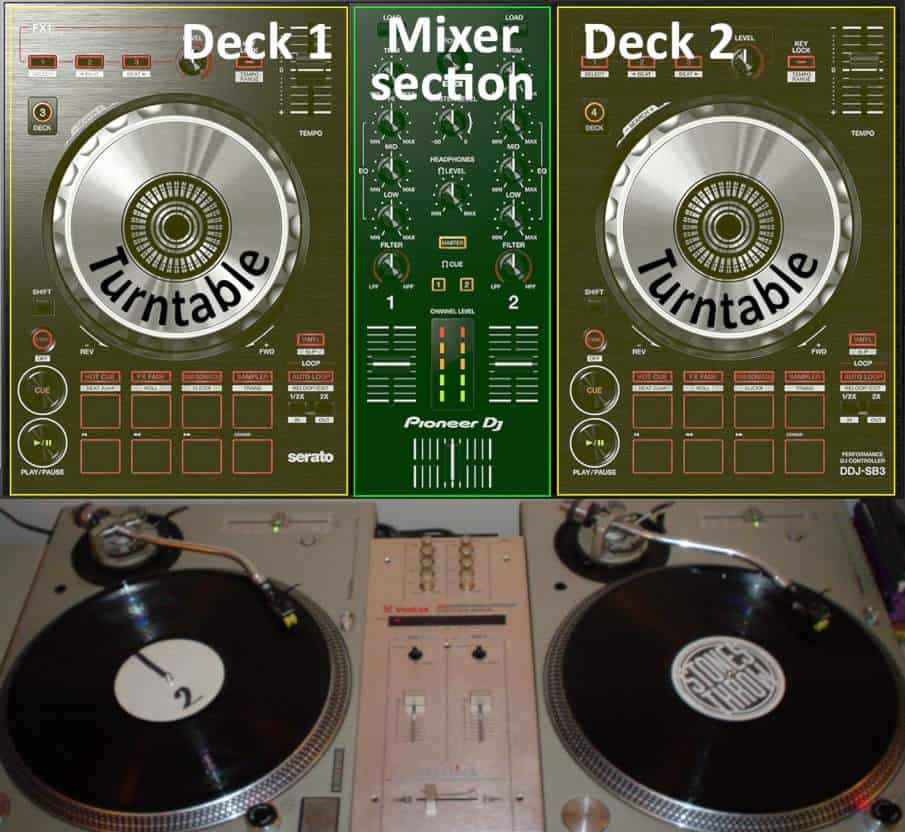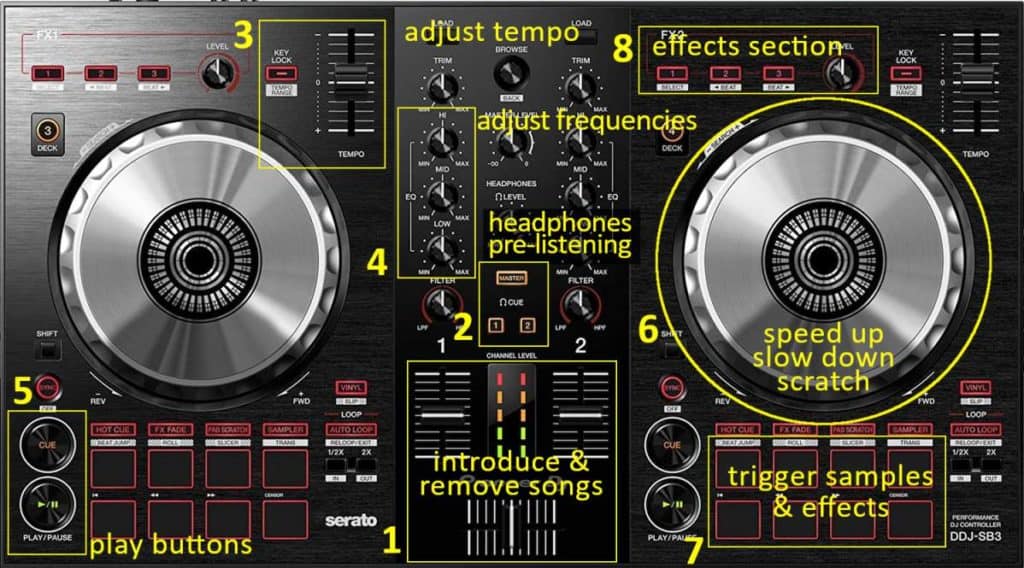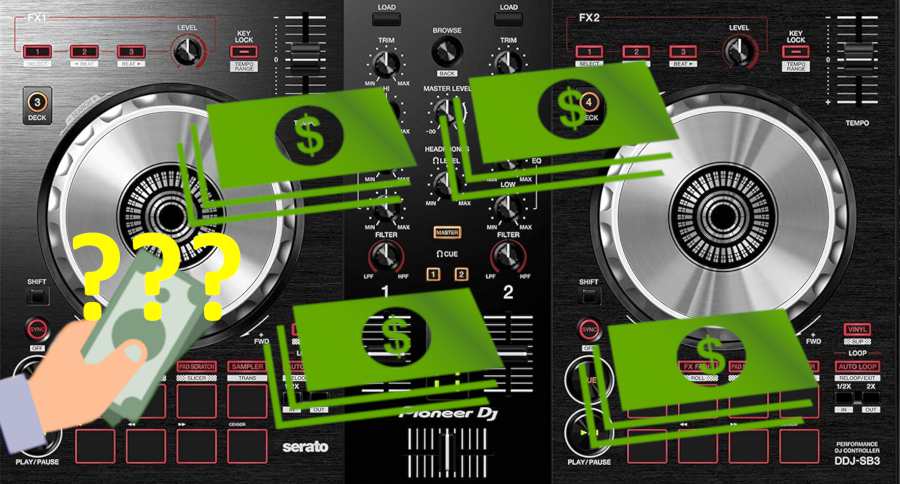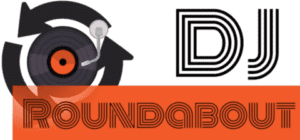A DJ controller is a USB device used by DJs to mix with their computers. Its purpose is to emulate turntables thanks to a DJ software. To do so, it embarks many controls such as backlit buttons, knobs, jog wheels, faders, etc. In other words, it is a specialized keyboard made for DJs.
In this article, I’m gonna detail what it does and how it works with basic functionalities. From that, you will understand what is a DJ controller. Then I will detail why you may need one and how much it will cost you. I am not going to use DJ jargon. I want this article to be useful for everyone and especially beginners.
A copy of the turntables + mixer setup
As a tool for DJ simulation software, DJ controllers mimic the setup DJs always used: 2 decks + 1 mixer. Instead of 2 vinyl turntables, the controllers come with two jog wheels. These are two big platters you can turn backward and forward.
As on vinyl, you can touch the edges to speed up or slow down a record. Touch the top of the platter and you can scratch the MP3s of your computer!

The mixer section will emulate the basic functions of a mixing console:
- Adjusting the frequencies: With the high, mid and low knobs. Also called EQing.
- Adjust the volume of each channel: With the trims or gains.
- Introduce and remove tracks: With the faders.
- More details of each section in the next heading.
However, do not be mistaken, the audio processing is not done within the device itself. Indeed, the purpose of the DJ controller is to let the computer do it in order to lower the price.
Indeed, a regular setup of 2 players + a mixer will start at no less than $1700. A least for something decent enough from Pioneer (a major brand in DJing).
A DJ controller from Pioneer having similar features can be found at only $250, like the DDJ-SB3 (link). That’s a big difference for many. Of course, you need a computer in order to make it work, but most people already have one.
You really need to see the DJ controller as a controller and nothing else. The controls command the software, and then the computer does the processing.
On top of that, many DJ controllers have a built-in soundcard. What it means is the computer will also send back the audio through the USB cable. Thanks to that, you will be able to plug speakers thanks to the connectors at the back of the unit.

Of course, the sound quality would not be as great as with a professional mixing console. But for the price, a DJ controller is a cool alternative. Moreover, a controller brings something other alternatives do not have: great portability.
What does a DJ controller do?
A DJ controller basically does everything a classic DJ player and DJ mixer would do. It adds some nice features though like the possibility to trigger samples from the computer. I am detailing below all the different sections of the DJ controller and their purpose.

- The first role of a DJ is to play songs without gaps between them. That’s what the faders or sliders in (1) are made for. The vertical faders are like volume controls. All the way up, the volume is maximum, all the way down = no volume at all. There is one per deck. One fader = one track.
The horizontal one controls both deck volumes at the same time. At the central position the volume is even for both tracks. On the left position, the volume of the left deck is maximum and the right one minimum. It allows to seamlessly fade between songs by moving only one fader instead of two. It is used a lot in scratching.
- However, a simple fade is not enough for a good mix. Indeed, fading a song with a high tempo with another with a low tempo will break the flow. That means people will stop dancing because there is a sudden change. That’s why DJ controllers have a tempo fader (or pitch) like (3). Moving the fader will change the tempo of the track on the current deck.
- To make sure the song are at the same tempo, the DJ can pre-listen the songs in his headphone. That’s the role of the selection buttons (2). After making the adjustments within the headphones, he can decide when to put the volume up with the faders (1).
- However, having the same tempo is still not enough for a good experience. You need on top of that to synchronize the rhythm. As you know, all songs have a rhythm, for most music it takes the form of beats: 1 – 2 – 3 – 4, 1 – 2 – 3 – 4, etc. It helps you find the groove.
Most of the time the rhythm beat takes the shape of drums. Therefore what the DJ does is synchronize the first kick drum of the song 1 with the first kick drum of the song 2.
Why is it important? Well, imagine you are dancing tangos. Each step of the tango is synchronized to the rhythm. If the DJ didn’t synchronize, your first song could stop at step 2 whereas the next song is at step 5. You will need to skip steps 3 and 4 of your tango, which is confusing and kill the vibe. Eventually, you stop dancing!
That’s where the jog wheels (6) take place. A DJ can speed up or slow down songs until they are completely synchronized. He does it by simply rotating the wheel.

- Then comes the frequencies. When doing a transition, a DJ adjusts the frequencies. Indeed, if you don’t do that there is too much happening. Like too much bass, or simply too many instruments. That is the purpose of the EQ knobs (4).
Most DJs use it to lower some frequencies of the song he is introducing. When the transition between two songs is finished, the EQs are put back in the central position (= no modification).
- DJ controllers also come with PADs (7). They are used to trigger samples from the computer or launch effects. They can also be used to launch specific parts of the songs, like the chorus, the drop, etc. In fact, they allow many functions because they can be mapped to pretty much everything.
- In (8) is the effect section. This is where you can add delays, reverbs, flangers, etc.
Note that sections (7) and (8) are not present on every DJ controller. Nowadays 90% of controllers have them though.
What are the DJ software that DJ controllers work with?
DJ controllers are made to work with Serato, Traktor, Virtual DJ, and Rekordbox. Most DJ controllers are pre-mapped for one of these software.
However, most DJ controllers propose “MIDI” options for the user to create his own mapping. Therefore each user can map each control (button, slider, knob) to the software function he likes. Thus, it is possible to connect the device to a software it was not made for.
Do I need a DJ controller? (4 cases you need one)
- Beginners
If you are a beginner and would like to start DJing, then look no further. A DJ controller is what you need! It is cheap and has all the options every DJ needs. DJ players and mixers are great for clubs, but a DJ controller is nothing more than you need to practice at home.
In fact, DJ controllers are much more useful to train with. Indeed, as they are connected to a computer, you can directly play with your MP3s. No need to put them in a flash drive. Fewer steps = less friction, and that’s a big plus when it comes to training in my opinion!
- Mobile DJs
Controllers are great for Mobile DJs because of the small form factor and weight. You can have a large music database on your computer for all the scenarios you will encounter. You can class all your music to your liking on the computer and be prepared to answer all requests. Easy to pack everywhere you go. Really perfect when you do weddings.
- Small rooms
For small apartments, DJ controllers are compact and easy to put away. A table and a computer and you are good to go! That’s true for beginners and confirmed DJs. In my case, I bought a DJ controller just for this reason.
- Low budget
As mentioned before, DJ controllers are cheap because they let the processing power to the computer. So if you already own a computer and have a low budget, buy a DJ controller!
You can also have a look at my post where I have listed 8 good reasons DJ controllers are great for beginners.
How much does a controller cost?

There are many options out there going from $80 to $2300. The price range is large because some controllers have additional functionalities. The pricey ones include a full built-in 4 channel mixer and are fully standalone (no computer needed!).
However, most DJ controllers are under the $1200 price tag. The average price is $800 and good entry points start at $250. If you are a beginner with a low budget, I would recommend going for the Pioneer DDJ-SB3 at $249. Otherwise, I have a full article detailing the price of DJ controllers according to their functionalities here.
